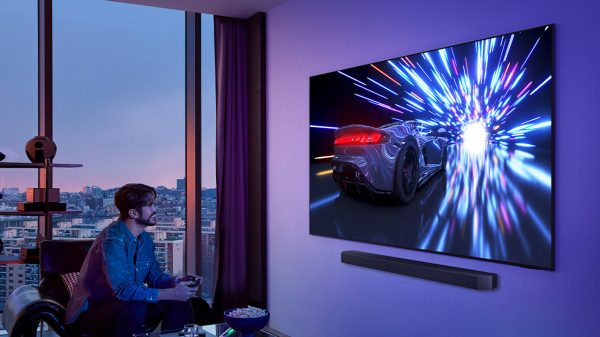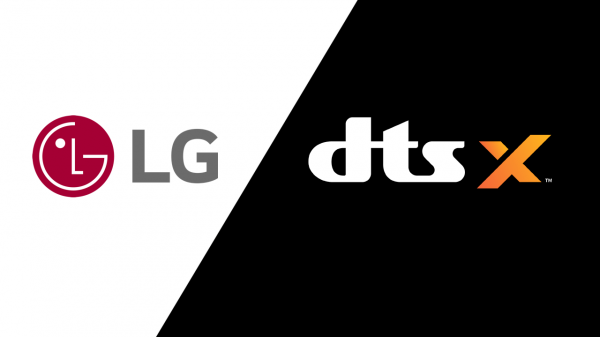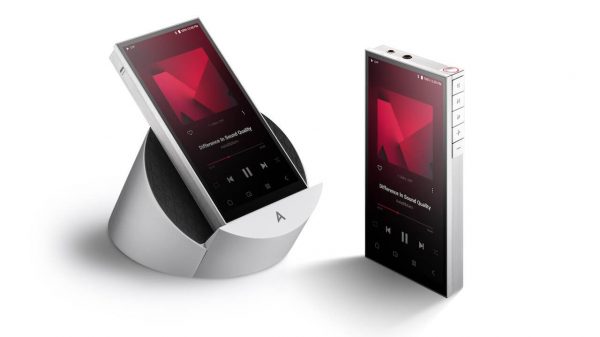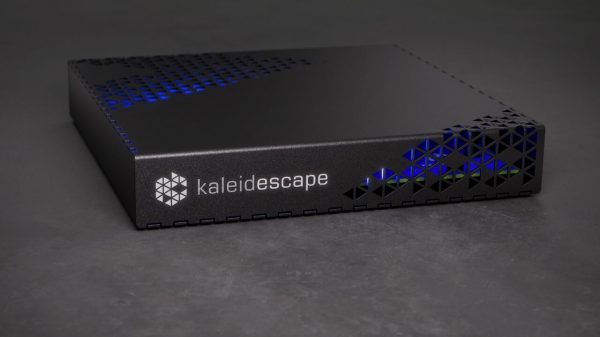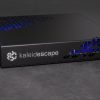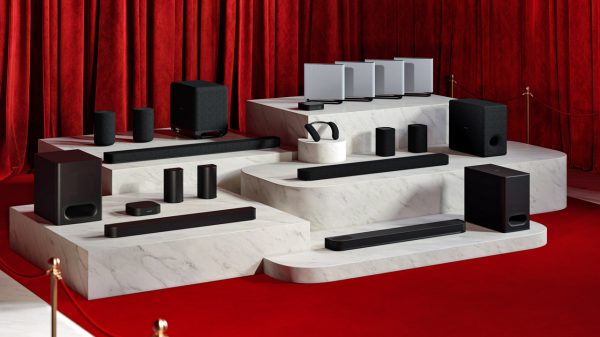Some of today’s soundbars cram in so many features, it’s hard to believe they still have room for an amplifier and speakers. One example of this trend is the Samsung HW-Q900A.

This Samsung entry is a 7.1.2 channel system that combines a 48-inch wide soundbar with a 160 watt wireless ported subwoofer. The Q900A also supports expansion to a 9.1.4 channel configuration with the purchase of the optional SWA-9500S wireless surround speaker kit.
Three speaker channels face directly forward, four of the speaker channels (two on each side) face outward and to the side, and two upward firing speaker channels are included to support Dolby Atmos height effects.

What You Get
Here is what the Samsung HW-Q900A comes with to get you started:
- Soundbar
- Wireless Subwoofer
- Remote Control with Batteries
- Soundbar and Subwoofer Power Cords
- AC/DC Adapter for Soundbar
- HDMI Cable
- Wall Mount Guide and Hardware (2 Holder Screws, 2 M4 x L10 Screws, 2 Bracket-Wall Mounts, 4 Rubber Feet.
- A digital optical cable is not included.
Connections
The connections provided by the Samsung HW-Q900A Soundbar include:
- 2 HDMI inputs with Dolby Atmos/DTS:X, 4K/60Hz video, and HDR10/10+, HLG pass-through support.
- 1 HDMI output with ARC/eARC support.
- 1 Digital optical audio input with 2-channel PCM, Dolby Digital, and DTS 5.1 support.
- 1 USB Service Port – This is used for installing firmware updates from a USB flash drive. It can’t be used to playback media files stored on USB flash drives.
NOTE: No analog audio input is provided.

Set-Up
Here are the steps to set up the HW-Q900A.
- Place the soundbar (wall-mounting hardware is provided for the soundbar if you choose that option). Temporarily place the subwoofer where you think you want it (more on this later).
- Connect the included HDMI cable from the soundbar to the HDMI-ARC/eARC port on your TV.
- (Optional) Connect a digital optical cable from the TV to the soundbar.
- (Optional) Connect a source device(s) to one or both of the soundbar’s HDMI inputs. This is a good option if you run out of HDMI connections on your TV.
- Plug the soundbar and subwoofer into power with their detachable power cords.
- Turn the soundbar on and the subwoofer should automatically pair with it.
- Put batteries in the remote and start using your system.
Complete instructions come in the box, or you can download them directly from the Samsung website (pdf file).
Using HDMI-ARC/eARC
HDMI-ARC and eARC allow you to connect all your source devices to a TV and then audio can be transferred from the TV to the soundbar using the same HDMI connection that transfers video passing through from the soundbar to the TV from the Soundbar’s other HDMI connections.
This means you don’t have to make a separate digital optical connection from the TV to the soundbar to hear TV audio. This is especially convenient if you have a Smart TV.
ARC is limited to stereo, Dolby Digital, and DTS 5.1 audio. If your TV has HDMI-eARC, you can access advanced surround formats such as Dolby TrueHD, Atmos, DTS-HD Master Audio, or DTS:X from the TV or devices connected to the TV.
For TVs that only have the ARC option, the Q900A provides two HDMI inputs for connecting an external device which allows up to 4K video pass-through and access to the more advanced surround formats.

The Subwoofer
The subwoofer is fairly large for a soundbar system. You won’t lack deep tight bass for movie viewing, but it may be a little soft in its default setting. However, the Q900A provides separate soundbar and subwoofer level controls so you can balance the two to your listening preference.
The subwoofer’s low-frequency drop-off point is approximately 35Hz which is respectable for a soundbar/subwoofer system.
Don’t place the subwoofer directly in any corner and think you’re done. Moving it 6-inches or more from the corner will decrease its output but also tighten up its impact and avoid overloading the room.
Since the sub is wireless, you don’t need a cable to connect it to the soundbar, but it does require AC power (cord provided).
When you plug the power cord into the sub, it comes on and starts looking for the soundbar. When I plugged the subwoofer into power, it paired with the sound automatically. If the subwoofer doesn’t pair an ID set button is provided on the rear of the subwoofer and the rear of the soundbar.
The ID set button on the soundbar can also be used to pair the optional wireless surround speakers (requires additional purchase).

Surround Sound
In addition to its left, center, right front, left and side-channel speakers, the Q900A features two additional height channel speakers to support Dolby Atmos and DTS:X within the soundbar which is where it gets its 7.1.2 channel label.

Performance
Playing a variety of movies and music, the Q900A easily fills a 15 x 20 foot room.
However, although the soundbar and subwoofer easily filled the room with horizontally front and site-directed sound, the soundbar’s vertically directed height channels aren’t always effective in bouncing sound off the ceiling accurately for Dolby Atmos/DTS:X content (I have low flat ceilings).
Although Dolby Atmos height channels are being incorporated in more soundbars these days, if you are looking for a “knock-your-socks-off” Dolby Atmos experience, consider a home theater receiver/speaker setup where ceiling or high-wall mounted speakers are in the mix for the height channels.
That being said, the height channels in combination with the rest of the soundbar speakers provided a good up, out, and wide front-stage soundfield that “filled” the space between the TV and seating position rather well.

Sound Modes
The Samsung Q900A provides several audio settings that allow you to tailor the sound further.
There are four preset sound modes:
- Standard – Outputs the original input sound format.
- Surround – Provides a wider soundfield.
- Game Pro – Provides a more immersive soundfield for gaming.
- Adaptive Sound – Analyzes and optimizes the sound content in real-time to provide the optimal listening experience.
Additional audio settings include Auto EQ (Equalization), Treble, Bass, Lip Sync, Center Level, Side Level, Front Top Level, and Virtual Speaker on/off.
TIP: You can also set the EQ manually, the adjustable frequency bands are: 150Hz, 300Hz, 600Hz, 1.2kHz, 2.5kHz, 5kHz, and 10kHz.
The Q900A also features Samsung’s Active Voice Amplifier (AVA). This feature brings out music vocals and dialog which may be low with both streaming and physical media (DVD, Blu-ray, UHD Blu-ray) content.
TIP: You can also raise the center channel volume to bring out vocals and dialog.
Airplay 2 and Bluetooth
The HW-Q900A supports Apple AirPlay 2. You can stream audio to the Q900A from an iPhone, iPad, or Mac, from any installed music app, such as Amazon Music, Spotify, Tidal, YouTube Music, or Apple Music. You can combine the soundbar with AirPlay 2-enabled speakers in a multi-room audio setup.
The HW-Q900A doesn’t support Chromecast. However, you can connect a Chromecast plug-in media streamer to one of the HDMI inputs or stream music from Android phones using Bluetooth.
TIP: If you have a compatible Samsung Galaxy Android Phone, you can tap the phone on the soundbar and mirror music playback from the phone to the soundbar.
The HW-Q900A is compatible with the following streaming audio music formats: WAV, MP3, WMA, OGG, FLAC, AAC, ALAC, and AIFF.
Control Options
You can control the Q900A soundbar in the following ways:
- The provided remote control (or compatible Samsung or third-party brand TV or universal remote)
- Samsung SmartThings App
- Alexa
- Onboard controls
Provided Remote Control: Using the remote control may seem like the easiest choice, but one problem is that the LED status display is located on the top of the soundbar. This means that you can’t see it from a seated position. You have to stand over the soundbar to see the display – a really bad decision by Samsung.

Samsung SmartThings App: One solution is to use Samsung’s SmartThings app on an iOS or Android phone. This allows you to see the setting options on your phone’s screen. The SmartThings app is also required to connect the Q900A to your network Wi-Fi in order to set up Alexa and other control features.
The Samsung SmartThings app allows you to control some soundbar settings. This includes sound modes (Standard, Surround, Game, and Adaptive Sound), bass/treble, EQ (Equalizer), subwoofer level, voice enhancer, bass booster, and night modes on/off.

Alexa: The Q900A has Alexa built-in (the needed microphone is built into the soundbar). The Samsung SmartThings App allows you to set up both a mobile remote control and enable the Alexa feature.
You can use Alexa on the Samsung HW-Q900A just like you use it on an Amazon Echo. You can voice remote control commands, play music from compatible streaming services linked to your Amazon account, ask the time, the weather, turn the TV on/off. For example, when watching a movie or listing to music, you can ask the time or weather, and once Alexa is finished answering it returns the soundbar to the music or movie.

Onboard Controls: The HW-Q900A also provides physical controls located on the top of the soundbar unit. The controls include on/off, Multi-Purpose/Input selection, volume, and Alexa microphone on/off.
Final Thoughts
The 48-inch width of the HW-Q900A soundbar pairs well with 50-inch and larger TVs. Its low profile allows it to fit under most TVs without blocking the bottom of the screen. The soundbar can also be wall-mounted (hardware is provided).
The physical width of the soundbar also provides a wide stereo and immersive surround sound field. Several surround sound formats are supported including Dolby Atmos. Additional dialog enhancement, auto, and manual EQ, and further audio processing (including presets) provide a lot of listening flexibility.
The Samsung HW-Q900A works with TVs that have a digital optical output or HDMI-ARC/eARC connection. However, access to the Q-Symphony feature requires select Samsung 2020/21 TV models. In addition, SpaceFit is only available for use with select 2021 Samsung TV models.
- Q-Symphony combines TV speaker sound with the soundbar. This is intended to provide fuller front-stage sound.
- SpaceFit auto-calibrates the TV to get the best sound quality, in relation to your room.
NOTE: Q-Symphony and SpaceFit were not tested in this review.
Pros
- Easy to set up.
- Lots of audio settings including manual equalizer, center, and height channel level controls.
- Option to add wireless surround speakers for 9.1.4 channel surround sound capability.
- Two HDMI Inputs (4K/HDR video pass-through compatible)
- Alexa built-in
- Integrates with Samsung SmartThings mobile app.
Cons
- The subwoofer default volume level is a little low (it is adjustable).
- Dolby Atmos implementation is not always consistent.
- No analog audio input.
- Poor location for LED Status Display
- Some features only work with select 2020/2021 Samsung TVs
- Pricey!

Where To Buy It
The Samsung HW-Q900A can be found at several retailers including Amazon and Crutchfield, as well as direct from Samsung.com. Currently, it’s on sale for $1,299.99 $899 at all online stores thanks to Early Black Friday pricing.
The optional SWA-9500S Wireless Surround Speakers are also on sale, now selling for $299 $249 at Amazon, Crutchfield, and Samsung.com.
Budget Option
Also, check out our review of the Samsung HW-Q800A soundbar/wireless subwoofer system. That system has most of the features found on the HW-Q900A, including Dolby Atmos and Alexa, but is narrower, at 38.6 inches. Also, instead of 7.1.2 channels, the Q800A only provides 3.1.2 channels (left, center, right, 2 height channels, and, of course, the subwoofer channel). However, the Q800A can also be expanded into a 5.1.4 channel configuration with the purchase of the optional SWA-9500S wireless surround speakers.














